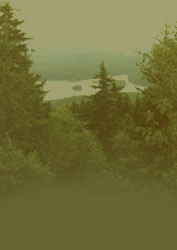|
Do you have something
happening in your corner of Washington? - Please call a member
or e-mail your observations to have them included here
June 2004:
Our resident bats are
reproducing right now! Little brown bat (Myotis
lucifugus)
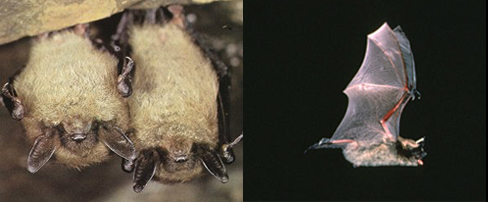 The little brown bat is a small mammal
with a body length of 3 - 31/2" and weighing approximately
1/8 to 1/2 an ounce. The wingspan of little brown bats range
from 6 - 8". Bats are the only mammals that engage in
truly active flight. As their name suggests they are glossy
brown above with a light buff color below. These bats can
live 20 to 30 years.
The little brown bat is a small mammal
with a body length of 3 - 31/2" and weighing approximately
1/8 to 1/2 an ounce. The wingspan of little brown bats range
from 6 - 8". Bats are the only mammals that engage in
truly active flight. As their name suggests they are glossy
brown above with a light buff color below. These bats can
live 20 to 30 years.
The Little Brown Bat is found from Labrador
west to central Alaska and south to the Appalachians in Georgia
and Arkansas. Located in most states except Florida, Texas,
and southern California. The little brown bat is found abundantly
throughout New Hampshire.
Little brown bats are insectivorous, eating a variety of insects
including some agricultural pests. They can eat 50% of their
own body weight each evening. During gestation and lactation,
even more insects are consumed. These nocturnal mammals use
echolocation to navigate and locate prey.
Bats hear high frequency sounds emitted by their
prey enabling them to distinguish contracting a muscle in
the ear, these bats can block out their own sounds while still
detecting prey. Little brown bats feed primarily over wetlands
and other still water where insects are abundant. They use
rivers, streams, and trails as travel corridors to navigate
across the landscape. Bats will occasionally swoop down close
to mammals to indulge on the insects that swarm around them,
not to make a nest in the hair.
Little brown bats hibernate in clusters during
the winter months, though little is known on hibernation locations
in New Hampshire. Caves or mines are preferred but large tree
cavities with favorable microclimates may be used. In order
to minimize evaporative losses the humidity in these hibernation
areas must be high, preferably over 90%. A constant temperature
of 40 degrees F is desirable for hibernation.
Sexual maturity is reached in 6 to 9 months
for females and a year for males. Breeding occurs from September
to October but the female stores the sperm for fertilization
in the spring. The young are born from mid-June to early July.
Little brown bats generally have one offspring per year, occasionally
two. The young become self-supporting within a month.
Little brown bats seek cavities for shelter,
roosting and brooding. In summer females brood their young
in dark, warm sites such as barns, attics, caves, hollow tree
cavities and other protected areas. Little brown bat roost
sites are highly variable and not well known. In temperate
regions, they often use cavities along forest edges with high
sun exposure.
Management of bats
• Suitable roost sites for bats can be maintained by
conserving standing dead trees (snags) along riparian areas,
forest edges and in regenerating stands. Maintaining snags,
particularly those over 14 inches width, in mature and over-mature
stands is also beneficial.
• Avoid any disturbance of bats during hibernation.
• Avoid handling bats and vaccinate dogs and cats for
rabies.
• Bat houses promote public awareness of bats, although
their effectiveness is uncertain. To encourage bats, place
the house in an area that receives at least four hours of
sun exposure and is within a quarter mile of streams or rivers.
A darkened bat house will absorb more heat and be more effective
in cooler regions such as New Hampshire.
Your opinion of bats may be less favorable if you find them in
your living quarters.
First thing, do not use pesticides. Adult bats
leave their roosts to feed every night and don't need to be
coaxed out. If this is a nursery colony, wait until the young
can fend for themselves. This doesn't take long -- about five
weeks. Most bat pups are born in late June or early July;
so by mid-August (these dates are for Indiana), even the youngsters
should be weaned and well on their way to independence.
Assuming you didn't do anything to knock him
down, a bat on the floor is probably sick. It should not be
handled with bare hands. Contrary to folklore, bats are no
more likely to carry rabies than any other woodland creature.
However, taking the chance is foolish. Unlike birds, most
bats find it difficult to take flight when lying on a horizontal
surface; they normally get airborne by falling instead of
flapping their wings. So you should be able to scoop it up
in a shovel or dustpan and take it outside.
Healthy bats are very mobile and you probably
aren't going to be able to catch them. The best way to get
rid of them is to determine where they are getting in and
out. You can usually figure this out by the guano on or below
the entrance. Wait until they leave to feed, then nail or
staple a screen or fine hardware cloth over the opening(s).
Do not use netting -- they can get entangled in it -- and
they are very good at getting around any fabric. You will
be rid of most of them after the first night. If you have
some stragglers, they will get very hungry very quickly. Take
down the hardware cloth the following evening, let them out
too, then put it back up. If the rest of your residence or
outbuilding is bat-tight, that should take care of it.
--National Speleological Society (promoting
the study & conservation of caves)
http://www.caves.org
For more information on bats visit the Bat Conservation International
website – http://www.batcon.org/
May 2004:
The Fisher: New Hampshire’s Rodney
Dangerfield

Historically speaking, New Hampshire’s Fisher,
like Rodney Dangerfield, got no respect. Although fishers
are now widespread, many of the state’s citizens would prefer
to have the fisher exterminated, or nearly so. Fishers are
blamed for all manner of problems. The fisher has seemingly
always been a creature of mystique, mystery, and fear. Commonly—and
mistakenly—called a “fisher cat,” the fisher has endured the
scorn of generations. Rabbits, partridge, pheasants, turkeys,
horses, and children are supposedly all vacuumed up by the
fishers’ relentless marauding. This is NOT the fisher I know!
Contrary to popular belief, house cats are not
a regular food item for fishers. Scientific studies show that
fisher prefer to eat small prey species. Mouse-sized animals
make up about a third of their diets, and a smaller proportion
is snowshoe hare. Most of the fisher’s diet consists of mice,
small birds, fruit, and berries, as well as deer in the form
of carrion. Cat hairs were found in only one of over 1,000
stomachs examined in 1979 and 1980.
Fishers remain one of the most secretive and
mysterious characters on the wildlife scene. About the size
of a cat (measuring 20 to 25 inches long without the tail,
and weighing about 6 to 12 pounds) a fisher has shorter legs
and a longer body than a cat, so it looks more like its true
relatives, the weasel, mink, and otter. Fishers appear to
be all black, but the fur around their face and shoulders
is lighter in color. Solitary animals, fishers can be active
day or night. They tend to avoid field and open land without
overhead cover, preferring forested areas, especially those
with the densest canopies, like evergreens.
Fishers, along with most of New Hampshire’s
other furbearers, were nearly exterminated from the state
in the years before the Civil War because unregulated trapping
since the mid-1600s had taken its toll. Habitat loss also
contributed to the decline in the fisher population. The forested
habitat preferred by the fisher was at a premium in those
days, because much of the New Hampshire’s land was in agricultural
use. Some measure of protection was afforded the fisher in
the early 1900s, but it was not until 1934 that total protection
was finally given to the few residential fisher left in the
North Country. The remnant population rebounded, re-establishing
themselves in the state from north to south. It’s not true
that fishers were imported into the state in order to control
porcupine numbers (though they are one of the few animals
that prey on porcupines); rather, fisher populations came
back once they were given complete protection. The fisher
was again abundant enough in 1962 to declare an open season.
During the early 1970s the value of fisher pelts soared, leading
to another population crash in 1976. After a couple of years
of closed seasons, fisher trapping re-opened in 1979 with
a shortened season and restricted bag limits. The population
has steadily increased since then, with trappers taking about
a thousand fishers a year in the late 1990s, despite a much
lower pelt value.
Based on evidence from the state’s trappers,
Fishers are as abundant today in New Hampshire, especially
in the southern third of the state. Fish and Game closely
monitors changes in the population levels to assure there
won’t be another collapse in the number of fishers in the
state. We don’t want history to repeat itself, because this
secretive mammal is part of what makes New Hampshire such
a special and wild place to live.
--Eric Orff, Wildlife Biologist
March 2004:
Bored with winter?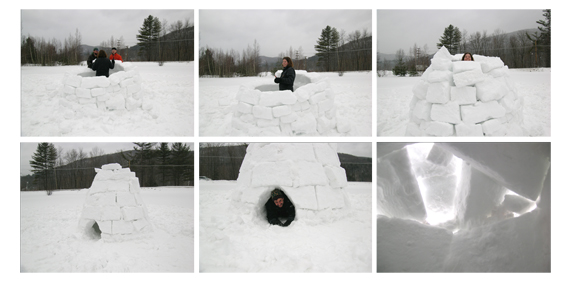
Why don't you build an igloo. It's a fun activity
for adults and children. Mike and Carol Andrews went to an
igloo building class at Yestermorrow
Design Build School in Warren, VT. Bert Yankeliun, engineer
from the cold Regions Research Lab showed us how. The
Montshire Museum also holds classes for igloo building
enthusiasts.
Building an Igloo
The following is reprinted from "The Complete Wildnerness
Training Guide" written by Hugh McManners and published
by Dorling Kindersley.
From Chapter Three, "Living In The Wild"
Provided temperatures remain below 32 degrees F, constructing
snow shelters is relatively easy. Sheltering from the wind
is the first priority, since the wind can drastically decrease
the air temperature. Temperatures below 14 degrees F become
increasingly unpleasant, so that it becomes necessary to construct
shelters in which heat can be retained extremely well. These
can range from a simple, hollowed-out heap of snow to an igloo,
which can take a few hours to construct. In a long-term shelter,
such as an igloo, heavy, cold air can be diverted away from
the occupants by digging a cold sink to channel the air down
and away from the shelter. It is important to allow for adequate
ventilation in all snow shelters in order to prevent suffocation.
1. Cut blocks from dry, hard, hard snow, using
a snow saw or large knife. Each block
should be about 3 ft. (1m) long, 15 in.
(40cm) high, and 8 in. (20cm) deep.
2. Form a circle with blocks around the hole
created where you cut the blocks. Cut the circle
in a spiral from the top of the last block to the
ground ahead of the first block. Make sure the
cut angles to the inside of the circle. This will
make it easy to construct a dome.
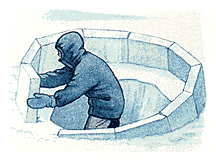
3. Build up walls, overlapping the blocks and
shaping them so that they lean inward. Cut a hole
under the wall for the cold sink and entrance.
Put several blocks along one wall as a sleeping
platform.
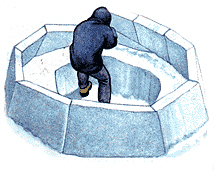
4. The last block must initially be larger than
the hole. Place the block on top of the igloo, then,
from inside, shape and wiggle it to slot exactly into
the hole.
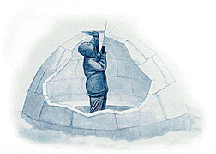
5. Hot air from your body and stove rises and
is trapped inside the dome. Cold air falls into the
sink and flows away to the outside. It is essential
to cut ventilation holes in the walls with an ice ax.
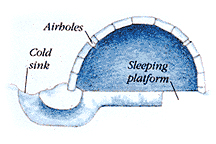
Finished Igloo. With warmth inside
the igloo, the surface of the walls will melt and freeze over,
to form a smooth, airtight ice surface. The roof over entrance
tunnel prevents snow from blowing into igloo.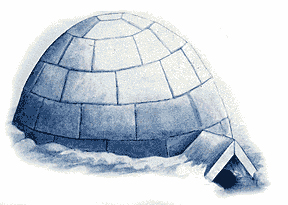
WARNING!
It is vital to make at least one air hole in the roof to avoid
suffocation. The igloo will get very warm inside with heat
from your body, even if it is cold and windy outside. Without
ventilation, lethal carbon dioxide will build up. Also, the
use of stoves in an enclosed shelter is not recommended due
to dangerous build-up of carbon monoxide.
Note: Unless the snow has been packed by the wind it is advisable
to prepare the snow the day before by shoveling snow into
a pile, then tamping it down with snowshoes. It is left over
night to harden.
February 2004:
New Hampshire's Seven Sleepers
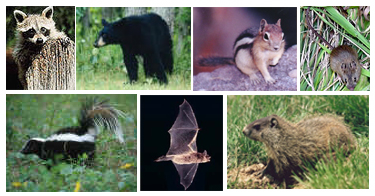
Seven types of mammals dodge the
depths of New Hampshire's winter by snoozing it away. Bats,
woodchucks, chipmunks and jumping mice go into a deep sleep,
or hibernation. For these animals, life nearly ceases; they
are at death's door. Yet, somehow, an alarm clock built into
their bodies awakens them at just the right time. Imagine
if you could hit the snooze button for four more months! Not
only do these animals get to sleep as long as the average
teenager, they actually have a weight loss program that works
-- the winter sleepers lose between 25 and 50 percent of their
weight while sleeping. Rounding out the seven sleepers, bears,
raccoons and striped skunks sleep during the cold months,
but not as deeply as the true hibernators. Sometimes they
snooze only during the coldest, snowiest parts of the winter.
New Hampshire's seven wildlife sleepers are:
Woodchucks are
masters of winter sleep. By late September, when air temperatures
drop into the 40s, woodchucks go into hibernation. The woodchuck's
weight will drop by about half over the winter. Its heart
rate plummets from 105 beats per minute to just 4, and body
temperature drops from 104 degrees F to about 38.
Bats are
also true hibernators. By late August or September, five species
of New Hampshire bats are headed for their winter dens. These
are usually caves or mines, not necessarily in this state,
but possibly as far as 200 miles away. The last days of summer
were spent adding about 25 percent to their body weight in
order to have enough fat to last the seven months in hibernation.
Bats' heartbeat slows from 210 per minute to just 8. A bat's
body temperature may drop from nearly 100 degrees F to 32.
Shivering prevents their body temperature from dropping below
freezing.
Jumping mice,
both woodland and meadow, occur across the state and, like
bats and woodchucks, are true hibernators. They curl into
a little ball and sleep for two or three weeks at a stretch,
briefly awaken, then resume their torpor. Their body temperature
hovers just above freezing. Ý Chipmunks are winter wanderers
between weeks-long periods of sleep. These little creatures
take the time in late fall to store a cache of winter food
which they eat during waking periods over the winter. Typically,
chipmunks have excavated one or two chambers in their underground
burrows and have filled them with hundreds of nuts. They,
too, are true hibernators, as their body temperature drops
from 96 to 106 degrees F to as low as 42-45 degrees F. Their
heart rate slips from 60 per minute to 20. A mild winter day
with little snow and an abundance of acorns will draw chipmunks
out of the den for a winter scamper.
Bears may
double their weight in late fall in preparation for denning.
Autumns with a lack of nuts and other foods, as we experienced
in New Hampshire in 2003, can send some bears into their dens
as early as September. During falls with an abundance of nuts,
especially beechnuts or acorns, bears often will stay active
into December. Bears usually build a den on top of the ground
or under a blow-down or brush pile. Their winter sleep is
not as deep as that of the true hibernators, as bears remain
alert and can run away or defend themselves if disturbed.
Their body temperature drops only about 10 degrees, from 100
degrees F to 90. Respiration drops more significantly, from
about 40 to 8-10 breaths a minute. Unlike chipmunks, bears
do not eat or drink or even relieve themselves during the
5-6 months of denning. Yet adult female bears give birth to
two or three cubs in January about every other year. They
are able to nurse the cubs and care for them during the coldest
of months by relying on body fat stored from the previous
fall.
Racoons
and striped skunks are the last of the winter
sleepers. Unlike the true hibernators, these animals may sleep
only during the coldest temperatures and the deepest snows,
but remain active periodically throughout the year. There
is no dramatic reduction in their body temperatures, heart
rate or respiration. Life goes on, just at a slower pace.
Just like us humans! To conserve energy, both raccoons and
skunks congregate in communal dens. Often, it will be the
mother and her young from the summer who will den together,
but sometimes as many as 12 to 20 raccoons may den together.
Skunks enjoy mixed company of other skunks, as well; there
can be 20 or more in a den, but usually no more than 10. Skunks,
especially females, prefer to make their winter dens under
or in buildings. Have you noticed a telltale odor of skunk
this winter? If you have, get ready for the blast of reality
when skunk-breeding season rolls around in January! Male skunks
may travel over two miles a night in search of that den full
of vivacious babes. Squabbling males or reluctant females
may cause a stir that will include some spraying. Keep that
clothespin handy! The denned skunks tend to have two or three
brief active periods each day, each lasting less than 10 minutes.
Skunks have a slight depression in body temperature and lose
between 40 and 58 percent of their body weight.
New Hampshire's seven sleepers
are all snuggled into their dens for a long winter's nap.
Wouldn't it be nice to sleep through that next big snowstorm,
or, better yet, that ice storm when the power is out? Plus,
great news - "you snooze, you lose." If Christmas dinner,
ribbon candy and holiday parties have you putting on a few
extra pounds, remember, the solution is only a nap away.
--Eric Orff, Wildlife Biologist
To view yearly archives of our "New In
Nature" series click on year you wish to see.
2002
2003
2004
2005
2006
2007
2008
2009
2010
2011
2012
|


